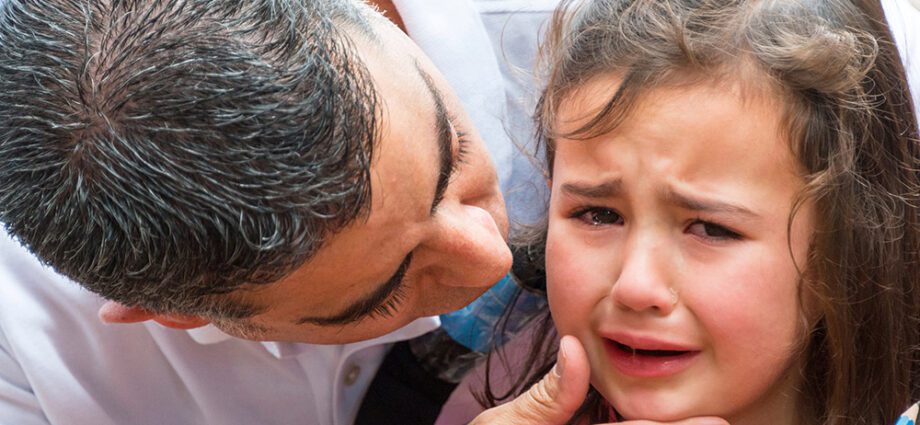Daptar eusi
Takwa anyar di barudak, teuing kakeunaan
Barudak sieun poék, ajag, cai, ditinggalkeun nyalira… Kolot terang ku manah yén momen-momen éta budakna panik sareng ceurik pisan aranjeunna sieun. Sacara umum, aranjeunna ogé terang kumaha nenangkeun aranjeunna sareng ngajamin aranjeunna. Dina taun-taun ayeuna, kasieunan anyar timbul diantara anu bungsu. Di kota-kota gedé, barudak dicaritakeun beuki kakeunaan gambar-gambar ganas anu matak pikasieuneun. Dekripsi kalawan Saverio Tomasella, dokter dina élmu manusa sarta psychoanalyst, panulis "sieun leutik atawa teror badag", diterbitkeun ku Leduc.s éditions.
Naon sieun di barudak?
"Salah sahiji kajadian anu paling penting anu bakal dialami budak umur 3 taun nyaéta nalika anjeunna uih deui ka sakola pabinihan," saur Saverio Tomasella mimitina. Budakna ti dunya anu ditangtayungan (pabinihan, emban, indung, nini…) ka dunya anu dicicingan ku seueur budak leutik, diatur ku aturan sareng konstrain anu ketat. Pondokna, anjeunna terjun kana kaributan kahirupan koléktif. Kadang-kadang ngalaman salaku "leuweung" nyata, sakola teh tempat munggaran sadaya pamanggihan. Sababaraha barudak bakal butuh waktu leuwih atawa kurang pikeun adaptasi jeung lingkungan anyar ieu. Sok sanajan kaayaan anu tangtu bakal nyingsieunan budak leutik anu nyandak léngkah kahijina di TK. "Hadé pisan pikeun déwasa janten waspada pisan salami periode penting ieu mimiti sakola. Mémang, psikoanalis negeskeun kanyataan yén urang maksakeun budak leutik kedah nyéépkeun diri, janten otonom, nurut sababaraha déwasa, nuturkeun aturan paripolah anu saé, jsb. ka budak leutik. Anjeunna sering sieun kalakuan anu goréng, kuciwa, henteu ngajaga laju, ”saur spesialis. Mun anak bisa tetep simbut na kalawan anjeunna, comforts anjeunna. "Éta cara pikeun murangkalih pikeun ngajaminkeun dirina, kalebet ku nyeuseup jempolna, bentuk kontak sareng awakna mangrupikeun dasar", khususna psikoanalis.
Sieun anyar anu nyingsieunan barudak
Dr Saverio Tomasella explains that he receives more and more children in consultation who evoke fears linked to new modes of communication in large cities (stations, metro corridors, etc.). “The child is confronted with certain violent images on a daily basis”, denounces the specialist. Indeed, screens or posters stage an advertisement in the form of a video, for example the trailer of a horror film or one comprising scenes of a sexual nature, or of a video game, sometimes violent and above all which is meant to be adults only. “The child is thus confronted with images which do not concern him. Advertisers primarily target adults. But as they are broadcast in a public place, children see them anyway, ”explains the specialist. It would be interesting to understand how it is possible to have a double talk to parents. They are asked to protect their children with parental control software on the home computer, to ensure that they respect the signage of films on television, and in public spaces, “hidden” and not intended images. toddlers are displayed without censorship on city walls. Saverio Tomasella agrees with this analysis. “The child says it clearly: he is really afraid of his images. They are scary for him, ”confirms the specialist. Moreover, the child receives these images without filters. The parent or accompanying adult should discuss this with them. Other fears concern the tragic events in Paris and Nice in recent months. Faced with the horror of the attacks, many families were hit hard. “After the terrorist attacks, televisions broadcast a lot of highly violent images. In some families, the evening television news can take up a fairly large place at mealtimes, in a deliberate desire to “keep informed”. Children living in such families have more nightmares, have less restful sleep, pay less attention in class and sometimes even develop fears about the realities of everyday life. “Each child needs to grow up in an environment that reassures and reassures them,” explains Saverio Tomasella. “Faced with the horror of the attacks, if the child is young, it is better to say as little as possible. Do not give details to the little ones, talk to them simply, do not use vocabulary or violent words, and do not use the word “fear”, for example ”, also recalls the psychoanalyst.
Sikep kolot diluyukeun jeung sieun budakna
Saverio Tomasella categorical: "Murangkalih hirup kaayaan tanpa jarak. Upamana, poster atawa layar anu aya di tempat-tempat umum, dibagéakeun ku saréréa, boh déwasa boh barudak, jauh tina kepompong kulawarga nu ngayakinkeun. Abdi émut budak lalaki 7 taun anu nyarioskeun ka kuring kumaha sieun anjeunna di metro nalika ningali poster kamar anu terjun dina poék ", nyaksian spesialis. Kolot sering heran kumaha réaksina. "Upami murangkalih ningali gambar éta, éta kedah diomongkeun ngeunaan éta. Anu mimiti, dewasa ngamungkinkeun anak pikeun nganyatakeun dirina, sareng muka dialog sacara maksimal. Taroskeun ka anjeunna kumaha perasaan anjeunna nalika ningali gambar sapertos kieu, naon anu dilakukeun pikeun anjeunna. Nyaritakeun anjeunna sareng pastikeun yén memang, pikeun murangkalih umurna, éta lumrah pikeun sieun, yén anjeunna satuju sareng anu dirasakeun. Kolot tiasa nambihan yén éta leres-leres ngaganggu kakeunaan gambar sapertos kitu, ”terasna. "Leres, éta pikasieuneun, anjeun leres": psychoanalyst nu nyangka yén hiji teu kudu ragu ngajelaskeun eta sahingga. Sapotong nasihat sejen, teu merta Huni on subjek, sakali penting geus ngomong, dewasa bisa move on, tanpa méré teuing pentingna acara, ku kituna teu dramatize kaayaan. "Dina hal ieu, sawawa bisa ngadopsi sikep benevolent, attentive dengekeun naon anak geus ngarasa, naon manéhna nyangka ngeunaan eta", menyimpulkan psychoanalyst nu.










